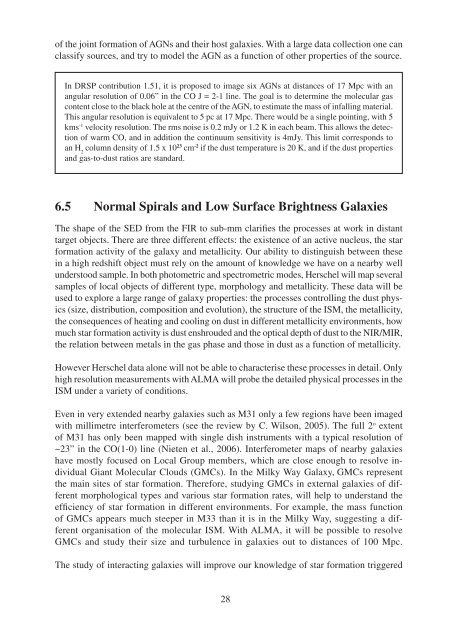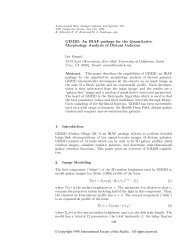4 Comparison of the ALMA and Herschel - ESO
4 Comparison of the ALMA and Herschel - ESO
4 Comparison of the ALMA and Herschel - ESO
You also want an ePaper? Increase the reach of your titles
YUMPU automatically turns print PDFs into web optimized ePapers that Google loves.
<strong>of</strong> <strong>the</strong> joint formation <strong>of</strong> AGNs <strong>and</strong> <strong>the</strong>ir host galaxies. With a large data collection one can<br />
classify sources, <strong>and</strong> try to model <strong>the</strong> AGN as a function <strong>of</strong> o<strong>the</strong>r properties <strong>of</strong> <strong>the</strong> source.<br />
In DRSP contribution 1.51, it is proposed to image six AGNs at distances <strong>of</strong> 17 Mpc with an<br />
angular resolution <strong>of</strong> 0.06” in <strong>the</strong> CO J = 2-1 line. The goal is to determine <strong>the</strong> molecular gas<br />
content close to <strong>the</strong> black hole at <strong>the</strong> centre <strong>of</strong> <strong>the</strong> AGN, to estimate <strong>the</strong> mass <strong>of</strong> infalling material.<br />
This angular resolution is equivalent to 5 pc at 17 Mpc. There would be a single pointing, with 5<br />
kms -1 velocity resolution. The rms noise is 0.2 mJy or 1.2 K in each beam. This allows <strong>the</strong> detection<br />
<strong>of</strong> warm CO, <strong>and</strong> in addition <strong>the</strong> continuum sensitivity is 4mJy. This limit corresponds to<br />
an H 2<br />
column density <strong>of</strong> 1.5 x 10 23 cm -2 if <strong>the</strong> dust temperature is 20 K, <strong>and</strong> if <strong>the</strong> dust properties<br />
<strong>and</strong> gas-to-dust ratios are st<strong>and</strong>ard.<br />
6.5 Normal Spirals <strong>and</strong> Low Surface Brightness Galaxies<br />
The shape <strong>of</strong> <strong>the</strong> SED from <strong>the</strong> FIR to sub-mm clarifies <strong>the</strong> processes at work in distant<br />
target objects. There are three different effects: <strong>the</strong> existence <strong>of</strong> an active nucleus, <strong>the</strong> star<br />
formation activity <strong>of</strong> <strong>the</strong> galaxy <strong>and</strong> metallicity. Our ability to distinguish between <strong>the</strong>se<br />
in a high redshift object must rely on <strong>the</strong> amount <strong>of</strong> knowledge we have on a nearby well<br />
understood sample. In both photometric <strong>and</strong> spectrometric modes, <strong>Herschel</strong> will map several<br />
samples <strong>of</strong> local objects <strong>of</strong> different type, morphology <strong>and</strong> metallicity. These data will be<br />
used to explore a large range <strong>of</strong> galaxy properties: <strong>the</strong> processes controlling <strong>the</strong> dust physics<br />
(size, distribution, composition <strong>and</strong> evolution), <strong>the</strong> structure <strong>of</strong> <strong>the</strong> ISM, <strong>the</strong> metallicity,<br />
<strong>the</strong> consequences <strong>of</strong> heating <strong>and</strong> cooling on dust in different metallicity environments, how<br />
much star formation activity is dust enshrouded <strong>and</strong> <strong>the</strong> optical depth <strong>of</strong> dust to <strong>the</strong> NIR/MIR,<br />
<strong>the</strong> relation between metals in <strong>the</strong> gas phase <strong>and</strong> those in dust as a function <strong>of</strong> metallicity.<br />
However <strong>Herschel</strong> data alone will not be able to characterise <strong>the</strong>se processes in detail. Only<br />
high resolution measurements with <strong>ALMA</strong> will probe <strong>the</strong> detailed physical processes in <strong>the</strong><br />
ISM under a variety <strong>of</strong> conditions.<br />
Even in very extended nearby galaxies such as M31 only a few regions have been imaged<br />
with millimetre interferometers (see <strong>the</strong> review by C. Wilson, 2005). The full 2 o extent<br />
<strong>of</strong> M31 has only been mapped with single dish instruments with a typical resolution <strong>of</strong><br />
~23” in <strong>the</strong> CO(1-0) line (Nieten et al., 2006). Interferometer maps <strong>of</strong> nearby galaxies<br />
have mostly focused on Local Group members, which are close enough to resolve individual<br />
Giant Molecular Clouds (GMCs). In <strong>the</strong> Milky Way Galaxy, GMCs represent<br />
<strong>the</strong> main sites <strong>of</strong> star formation. Therefore, studying GMCs in external galaxies <strong>of</strong> different<br />
morphological types <strong>and</strong> various star formation rates, will help to underst<strong>and</strong> <strong>the</strong><br />
efficiency <strong>of</strong> star formation in different environments. For example, <strong>the</strong> mass function<br />
<strong>of</strong> GMCs appears much steeper in M33 than it is in <strong>the</strong> Milky Way, sug gesting a different<br />
organisation <strong>of</strong> <strong>the</strong> molecular ISM. With <strong>ALMA</strong>, it will be possible to resolve<br />
GMCs <strong>and</strong> study <strong>the</strong>ir size <strong>and</strong> turbulence in galaxies out to distances <strong>of</strong> 100 Mpc.<br />
The study <strong>of</strong> interacting galaxies will improve our knowledge <strong>of</strong> star formation triggered<br />
28




